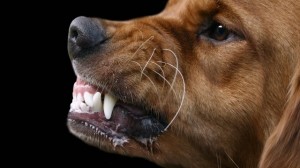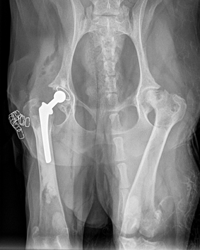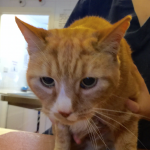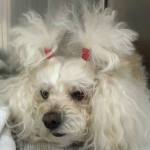News
Archive for June, 2015
Dental Offer
by admin on June 30th, 2015
Category: Special Offers, Tags:
Pet of the Month – June 2015
by admin on June 30th, 2015
Category: Pet of the Month, Tags:
Monty is our pet of the month. He can be seen here having his painkiller ‘patch’ changed as part of his treatment for Pancreatitis.
Pancreatitis is an inflammation of the pancreas. Unlike dogs, cats with pancreatitis do not usually show vomiting or abdominal pain as their initial sign. In more than 50 percent of affected cats, lethargy, poor appetite or not eating, dehydration, increased respiratory rate, and a lower-than-normal body temperature are the initial signs. Only about 35 percent of the cats with pancreatitis will vomit.
Diagnosing pancreatitis can be problematic. Ultrasound is one of the best methods, and new blood tests are helpful.
All cats with pancreatitis will need extensive fluid therapy and careful monitoring of their electrolytes. If the cat is vomiting, food may need to be withheld, but ideally not for more than 48 hours and pain control is essential.
He was been a wonderful patient and we are delighted to report that he is now fully recovered.
Fear Aggression In Dogs
by admin on June 30th, 2015
Category: News, Tags:
 Fear is one of the most common triggers for threatening or aggressive behaviour in dogs. But what is fear, why do some dogs become fearful of things that won’t actually harm them and what makes some of them go to the extreme of using threat or aggression when they are feeling afraid?
Fear is one of the most common triggers for threatening or aggressive behaviour in dogs. But what is fear, why do some dogs become fearful of things that won’t actually harm them and what makes some of them go to the extreme of using threat or aggression when they are feeling afraid?
What is fear?
Fear is one of the six basic emotions seen in all mammals and is healthy, normal and desirable. It causes unpleasant feelings when a dog is around anything that may harm him, prompting him to move away from it and so protecting him from danger. However, as the saying goes ‘a life lived in fear is a life half lived’. If a dog is excessively fearful this not only interferes with doing the things he needs to do to survive, such as going out to get food and be around other dogs, but it also affects his quality of life. Dogs therefore need to learn to balance the protective benefits of fear with the need to interact with others and explore their environment. All being well, puppies learn to do this as part of their normal development during the first 12 weeks of life. They then grow up able to balance curiosity and caution in a way that keeps them safe whilst allowing them to behave in a normal way.
What can cause a dog to be fearful?
Many things influence how dogs react to whatever is going on around them. Their physical state, including their genetic drives, age, breeding cycle, illness or pain, and some medications all play a part. Dogs also start learning before they are even born and every experience they have has the potential to affect their future behavior in some way. This combination of ‘nature’ and ‘nurture’ then combines to determine how the dog reacts to new experiences. This is discussed more in the article ‘Dog Aggression’.
Most of the time these influences ensure the dog is only afraid of things that pose a genuine threat to him. However, very occasionally one or more of them will cause the dog to feel afraid of things that don’t pose a real threat, or to react excessively if they do. For example poorly socialised dogs may be fearful of other dogs even if they are being friendly, and dogs that have been physically punished in the past may become afraid of anyone raising their arm even if they are not threatening to strike the dog. Equally a dog that has been attacked by another dog in the past may escalate to using very strong aggression such as snapping or biting in response to even very mild threat from another dog.
Why do we sometimes see fear aggression in dogs?
Fear aggression in dogs only tends to arise if the dog has no other way of dealing with something that is scaring him. When they are afraid, a dog’s instinctive reaction is to get away from the trigger so the unpleasant feelings it is causing stop. If the fear is being triggered by something inanimate, such as a car or sudden noise, the dog will typically achieve this by moving away or hiding. Dogs may also try to back away or hide if they are worried by a person or another dog. However, depending on the circumstances, the dog may also try to increase the distance between themselves and a human or canine target through communication.
In most cases this will involve the use of appeasing signals. These are intended to show the target that they don’t pose a threat and to ask to be left alone. They include things like licking the lips, turning the head away and cowering.
If the target reads these signals and backs away, the dog will then stop feeling so fearful. He may also feel less fearful the next time he is in the same situation as he will know the scary person or dog will leave him alone if he asks. However, these signals don’t always work. Some dogs may still behave aggressively due to their own problem behaviour. People also often don’t recognise or respond to these signals, and things like cowering may even make some well-meaning people get closer to the dog to try and reassure them. This can inadvertently make the dog more afraid, as they feel unable to get away from the person that is scaring them.
If appeasing signals don’t work some dogs may then try using threat to make the target back away instead. Low level threat is quite subtle and includes things like leaning forward, staring at the target or holding the tail erect.
Even when this looks confident it is still often underpinned by fear and is just the dog’s way of putting on a show of false bravado to increase the chance the target will back off. As with appeasing, if this works the dog is less likely to be fearful in the same situation next time. However this strategy may also sometimes fail, for the same reasons as appeasing does, causing some dogs to then use more obvious threat such as growling or snapping. This type of behaviour is what people are often referring to when they talk about fear aggression in dogs. This escalation will very often work to make the person or other dog back off. However some dogs may retaliate and some people will punish their dog for growling or snapping at them. This can then sometimes trigger the dog to bite.
Can some dogs show threat or bite without warning?
There are occasions on which a dog may appear to use higher level threat or aggression, such as lunging, snapping and biting, without having used appeasing signals or lower level threat as a warning first. Sometimes this will be because the warnings were there but weren’t seen. We don’t very often catch bites on video but when we do we almost always see all the warning signs that the target didn’t. Dogs can also learn that lower level signals don’t work or that they result in the target retaliating or punishing them, such as if someone smacks the dog or pins him down for growling (the latter is often called an ‘alpha’ or ‘dominance’ roll). The dog then learns to skip these warnings and go straight to using very high levels of threat or even biting. The reasons behind the behaviour are still the same. All that has changed is the speed with which the dog has escalated to a bite.
What should I do if my dog shows signs of threat or aggression?
Fear aggression in dogs isn’t very common. However, if your dog is using threat or aggression out of fear then he is in distress and so not only are the people or dogs it is targeted to at risk, but your dog’s own welfare is also being compromised. It is therefore important that you seek help as soon as possible for everyone’s safety and welfare, and to prevent the behaviour deteriorating. The first step is to speak to your vet to ensure there isn’t a medical cause for his behaviour. He or she will then be able to refer you to an appropriately accredited Clinical Animal Behaviourist who can diagnose the reason for the behaviour and help you change it.
Common appeasing signals in dogs:
- Licking their nose or lips
- Chomping – like chewing a toffee
- Looking away
- Turning or leaning away
- Pulling their ears back
- Narrowing their eyes
- Sniffing or licking the other’s muzzle or face
- Cowering
- Tucking their tail (it may still be wagging)
- Walking away, or trying to escape or hide
- Rolling onto their side or back whilst avoiding eye contact
Common threat signals in dogs:
- Becoming still and tense
- Staring at the target
- Leaning forward
- Holding their tail up
- Holding their ears up and forward
- Physically controlling the other e.g. blocking their way, pinning them down or holding them using their muzzle without using pressure
- Mounting
- Putting their head over the other’s neck
- Aggressive barking
- Growling
- Snarling
- Snapping
National Microchip Month
by admin on June 1st, 2015
Category: Special Offers, Tags:
Total Hip Replacement in Dogs
by admin on June 1st, 2015
Category: News, Tags:
 Hind limb (back leg) lameness is a common reason small animal patients present to a veterinary surgeon. This is a more frequent scenario in dogs but we also see cats with this type of lameness. The causes of hind limb lameness are varied, but hip pain is a frequent reason for our patients to become lame.
Hind limb (back leg) lameness is a common reason small animal patients present to a veterinary surgeon. This is a more frequent scenario in dogs but we also see cats with this type of lameness. The causes of hind limb lameness are varied, but hip pain is a frequent reason for our patients to become lame.
What causes hip pain in dogs?
There are many causes of hip pain, however hip dysplasia, and the subsequent development of osteoarthritis, is the most common condition leading to this in dogs. This condition is also recognised in cats. In smaller dogs with hip pain, commonly terrier-type or poodle-type breeds, a condition called ‘avascular necrosis of the femoral head’ or ‘Legg Calvé Perthes disease’ can be diagnosed. Some of these patients will respond to medical therapy, but what happens if the lameness and the pain persist despite appropriate medication?
Can surgery help?
In patients where medical therapy does not control the lameness or pain, surgery can be considered. In many of these cases, the changes in the hip joint are severe and there is no chance of a corrective surgical procedure being successful. We therefore look at surgical salvage procedures to help reduce pain and ideally improve limb function. The two main surgical procedures for the hip joint are ‘femoral head and neck excision arthroplasty’ (also called femoral head ostectomy – FHO) and ‘total hip replacement’ (THR).
Femoral head and neck excision arthroplasty
Femoral head and neck excision arthroplasty is where the femoral head (the ‘ball’ part of the ball and socket joint) is removed and a false joint is allowed to form. This can reduce pain and is a reasonable treatment option. However, limb function is not always good and in one study limb function was considered poor in over 40% of cases.
Total hip replacement
Our aim should be not only to improve comfort, but also to improve limb function as best we can. This can be achieved with total hip replacement. This is where the femoral head is removed and replaced with a metal ball and the socket (the ‘acetabulum’) is replaced with a plastic cup.
This procedure has a high success rate and can improve limb function to near normal. It has historically been recommended in large dogs but we now know that smaller dogs can benefit from this procedure and the implants have been manufactured small enough to use in small breed dogs and in cats.
There are several different systems available. The main differences between the systems are whether the implants are secured with cement or not – what we term ‘cemented’ or ‘cementless’ systems.
Questions to ask if you think your dog needs a hip replacement…
Is total hip replacement the best option for my pet?
All surgical procedures carry risk and total hip replacement in dogs is no different. The complication rate is approximately 10%, so the risks of surgery need to be weighed against the potential benefits. If there is a painful lameness that is poorly responsive to medical treatment including weight control, exercise control and painkiller medication, a total hip replacement is generally indicated.
Is there a reason why my pet may not be a candidate for surgery?
Infection elsewhere in the body (skin, ear or gums) can increase the risk of infection of the total hip replacement. If surgery has been performed on the hip previously, total hip replacement may not be appropriate or can carry a higher complication risk. An immature skeleton may prevent total hip replacement from being performed although recent evidence shows this is technically possible. Maturity of the skeleton often occurs between 8-12 months. The procedure is generally expensive and cost may prohibit this surgery for some owners.
Who will be doing the surgery?
Total hip replacement is a highly skilled procedure. It should ideally be performed by a surgeon(s) with appropriate level training and good levels of experience. It is important, as a pet owner, that you are as informed as possible before making a decision to have a total hip replacement performed and the bond between a surgeon and pet owner is very important. As a pet owner in the UK, you can request to be referred to whichever clinic you wish.
Can complications occur with total hip replacement?
In short, yes. The complication rate for this procedure is generally low, meaning that a high number of patients have an uneventful recovery period. The main complications for this procedure are infection and luxation (dislocation). Other complications are rare but include fracture of the femur, sciatic nerve problems, implant loosening and embolism at the time of surgery.
What aftercare is required after total hip replacement?
Your pet will require a significant period of rest after surgery (usually several weeks) followed by gradually increasing levels of lead exercise and then off-lead activity over several months. This should be discussed with your surgeon in detail prior to surgery.
What is the prognosis for my pet?
This is a procedure which can significantly improve the life of patients with chronic hip pain. Some owners report dramatic changes in not only the way that their pet uses the limb but also in the patient’s quality of life. A good to excellent outcome is expected in most patients.
Mizia
by admin on June 1st, 2015
Category: Pet of the Month, Tags:
Our pet of the month is Mizia, seen here recovering from a hysterectomy she urgently needed for pyometra.
Pyometra is an infection of the uterus (womb). It is a common condition in older female dogs that have not been speyed, but can occur in entire bitches of any age. Occasionally we see cases occurring in cats.
Each time a bitch has a season (usually about twice a year) she undergoes all the hormonal changes associated with pregnancy – whether she becomes pregnant or not. The changes in the uterus that occur with each season make infection more likely with age. A very common organism called E. coli, found in your dog’s faeces, usually causes the infection. We most commonly see cases of pyometra in the 4-6week period after a heat.
The symptoms usually develop around 6 weeks after the female has finished bleeding from her last season, but in some cases the bitch appears to have a prolonged season.
Early signs that you may notice are that your dog is:
- Licking her back end more than normal
- Off colour
- Off her food
- Drinking more than normal (and will probably urinate more)
These signs will progress and you may see:
- Pus (yellow/red/brown discharge) from her vulva
- She may have a swollen abdomen
- Vomiting
- Collapse
If left untreated signs will worsen to the point of dehydration, collapse and death from septic shock.





